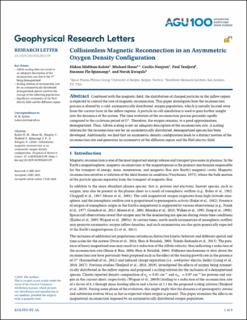| dc.contributor.author | Kolstø, Håkon Midthun | |
| dc.contributor.author | Hesse, Michael | |
| dc.contributor.author | Norgren, Astrid Elisabet Cecilia | |
| dc.contributor.author | Tenfjord, Paul | |
| dc.contributor.author | Spinnangr, Susanne Flø | |
| dc.contributor.author | Kwagala, Norah Kaggwa | |
| dc.date.accessioned | 2021-05-28T08:23:27Z | |
| dc.date.available | 2021-05-28T08:23:27Z | |
| dc.date.created | 2021-01-19T11:57:46Z | |
| dc.date.issued | 2020 | |
| dc.identifier.issn | 0094-8276 | |
| dc.identifier.uri | https://hdl.handle.net/11250/2756794 | |
| dc.description.abstract | Combined with the magnetic field, the distribution of charged particles in the inflow region is expected to control the rate of magnetic reconnection. This paper investigates how the reconnection process is altered by a cold, asymmetrically distributed, oxygen population, which is initially located away from the current layer in the inflow regions. A particle-in-cell simulation is used to gain further insight into the dynamics of the system. The time evolution of the reconnection process proceeds rapidly compared to the cyclotron period of O urn:x-wiley:grl:media:grl59941:grl59941-math-0001. Therefore, the oxygen remains, to a good approximation, demagnetized. Thus, Alfvén scaling is not an adequate description of the reconnection rate. A scaling relation for the reconnection rate for an asymmetrically distributed, demagnetized species has been developed. Additionally, we find that an asymmetric density configuration leads to a distinct motion of the reconnection site and generates an asymmetry of the diffusion region and the Hall electric field. | en_US |
| dc.language.iso | eng | en_US |
| dc.publisher | AGU | en_US |
| dc.rights | Navngivelse 4.0 Internasjonal | * |
| dc.rights.uri | http://creativecommons.org/licenses/by/4.0/deed.no | * |
| dc.title | Collisionless Magnetic Reconnection in an Asymmetric Oxygen Density Configuration | en_US |
| dc.type | Journal article | en_US |
| dc.type | Peer reviewed | en_US |
| dc.description.version | publishedVersion | en_US |
| dc.rights.holder | Copyright 2020 The Authors | en_US |
| dc.source.articlenumber | e2019GL085359 | en_US |
| cristin.ispublished | true | |
| cristin.fulltext | original | |
| cristin.qualitycode | 2 | |
| dc.identifier.doi | 10.1029/2019GL085359 | |
| dc.identifier.cristin | 1874200 | |
| dc.source.journal | Geophysical Research Letters | en_US |
| dc.source.40 | 47 | |
| dc.source.14 | 1 | |
| dc.identifier.citation | Geophysical Research Letters. 2020, 47(1), e2019GL085359 | en_US |
| dc.source.volume | 47 | en_US |
| dc.source.issue | 1 | en_US |

